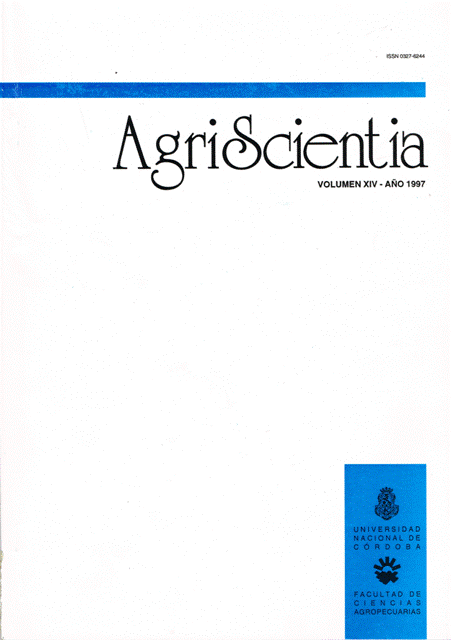Determination of vigor by tetrazolium in peanut (Arachis hypogaea L.) seeds under different storage conditions
Main Article Content
Abstract
At present, seed analysts do not have suitable test patterns to analyze vigor in peanut seed by Tetrazolium. The aim of this work was to prepare a dye pattern to determine the vigor of peanuts cv. Florman using various storage conditions in correlation with field test assays. The peanut cv. Florman seeds were stored with and without shell, submitted to accelerated aging conditions in order to enlarge the variability of the quality. The variables measured were percentage of germination, percentage of vigorous viable seeds, less vigorous, non-viable, and percentage of emergent plantlets at field. The results revealed that the Tetrazolium test is a suitable method to evaluate the quality of seed lots of peanuts cv. Florman, since different vigor levels can be established. These can be determined according to color variation, its intensity, and position on the embryonic apex and cotyledon. Thus, high vigor seeds show bright red carmine embryos and steady tissue when cut. The proposed dye pattern allows estimating the emergence of peanut seeds under field conditions.
Article Details

This work is licensed under a Creative Commons Attribution-ShareAlike 4.0 International License.
How to Cite
References
Association of Official Seed Analysts. (1983). Seed vigour handbook (Contribution No. 32, pp. 82-88). Association of Official Seed Analysts.
Bulan, P. (1988). Tetrazolium evaluation of Mungbean (Phaseolus aureus Roxb.) and Whitbean (Phaseolus vulgaris L.) seeds (MS Thesis). Mississippi State, Mississippi, 62 pp.
Frezzi, M. J. (1967). La semilla de maní y sus problemas. IDIA, 1-28.
Giandana, E. (a). (1992). Para optimizar la siembra de maní. Panorama Manisero, VI(20), 6-7. Córdoba, R.A.
Giandana, E. (b). (1992). Evolución de los rendimientos en maní en la Argentina. Panorama Manisero, VI(20), 12-13. Córdoba, R.A.
Gitali, Das, & Swati Sen-Mandi. (1992). Triphenyl tetrazolium chloride staining pattern of differentially aged wheat seed. Seed Science and Technology, 20, 367-373.
Hathayatham, A. (1988). Tetrazolium evaluation of chickpea (Cicer arietinum L.) and Austrian winter pea (Pisum sativum v. arvense L. Poir) seeds (MS Thesis). Mississippi State, Mississippi, 80 pp.
International Seed Testing Association. (1979). Manual para evaluación de plántulas en análisis de germinación (29th ed.). Instituto Nacional de Semillas y Plantas de Vivero. Madrid.
International Seed Testing Association. (1995). Handbook of vigour test methods (3rd ed.; J. G. Hampton & D. M. Tekrony, Eds.). Chairperson & Deputy Chairperson, Vigour Test Committee, 117 pp.
International Seed Testing Association. (1996). International rules for seed testing. Seed Science & Technology, 24, Supplement, 343 pp.
McDonald, M., & Phaneendranath, B. (1978). A modified accelerated aging seed vigor test for soybean. Journal of Seed Technology, 1, 27-37.
Pasha, M. K., & Das, R. K. (1982). Quick viability test of soybean seeds by using tetrazolium chloride. Seed Science & Technology, 10, 651-655.
Pérez, M. A., & Arguello, J. A. (1996). Deterioration in peanut (Arachis hypogaea L. cv. Florman) seeds under natural and accelerated aging. Seed Science & Technology, 23, 439-445.
Yaklich, R., & Kulik, M. (1979). Evaluation of vigor tests in soybean seeds: Relationship of the standard germination test, seedling vigor classification, seedling length, and tetrazolium staining to field performance. Crop Science, 19, 247-252.
Vaughan, C., & Moore, R. (1970). Tetrazolium evaluation of the nature and progress of deterioration of peanut (Arachis hypogaea L.) seed in storage. Proceedings of the Association of Official Seed Analysts, 60, 104-117.





